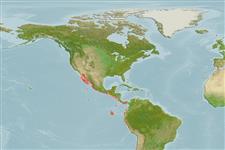>
Ophidiiformes (Cusk eels) >
Ophidiidae (Cusk-eels) > Ophidiinae
Etymology: Lepophidium: Latin, lepus, leporis = rabbit + Greek, ophis = serpent (Ref. 45335).
More on author: Gilbert.
Environment: milieu / climate zone / depth range / distribution range
Écologie
marin démersal; profondeur 73 - 307 m (Ref. 91765). Subtropical; 30°N - 21°N, 118°W - 108°W (Ref. 91765)
Eastern Pacific: Gulf of California and along the outer coast of Baja California as far north as Bahía Sebastían Viscaíno.
Taille / Poids / Âge
Maturity: Lm ? range ? - ? cm
Max length : 41.5 cm TL mâle / non sexé; (Ref. 86316)
Rayons mous dorsaux (Total) : 117 - 128; Rayons mous anaux: 97 - 108; Vertèbres: 66 - 70. This fine-scaled species have the following characteristics: pyloric caeca usually 5-6, typically 5 + 1; usually 3 rudimentary gill rakers on the upper arm of the first arch and 4-5 developed rakers on lower arm with 2-5 rudimentary rakers anteriorly, total gill rakers usually 11-12 (10-15); count of scale rows almost 30 between the occipital line and the dorsal-fin origin, 14-15 rows between the dorsal-fin origin and the lateral line, and about 255 lateral scale rows; dorsal-fin origin between neural spines 4-5 (rarely between 3-4); color of head and body rather uniformly dusky, silvery, or whitish along the belly; dorsal fin usually lacks a dark edge, and when present it is poorly developed; anal fin has an inconspicuous and narrow dark edge; orobranchial cavity usually pale, but the rear of the roof of the mouth may be dusky; esophagus blackish; stomach and hindgut pale (Ref. 91765).
Occurs benthically, from 210-307 m in the Gulf of California and 73-293 m on the outer coast (Ref. 91765). Oviparous, with oval pelagic eggs floating in a gelatinous mass (Ref. 205).
Life cycle and mating behavior
Maturities | Reproduction | Spawnings | Egg(s) | Fecundities | Larves
Robins, C.R., R.H. Robins and M.E. Brown, 2012. A revision of Lepophidium (Teleoastei, Ophidiidae), with descriptions of eight new species. Bulletin of the Florida Museum of Natural History 52(1):1-94. (Ref. 91765)
Statut dans la liste rouge de l'IUCN (Ref. 130435)
Menace pour l'homme
Harmless
Utilisations par l'homme
Outils
Articles particuliers
Télécharger en XML
Sources Internet
Estimates based on models
Preferred temperature (Ref.
123201): 12.1 - 15.6, mean 14 °C (based on 46 cells).
Phylogenetic diversity index (Ref.
82804): PD
50 = 0.5000 [Uniqueness, from 0.5 = low to 2.0 = high].
Bayesian length-weight: a=0.00219 (0.00121 - 0.00395), b=3.15 (2.99 - 3.31), in cm total length, based on LWR estimates for this species & Genus-body shape (Ref.
93245).
Niveau trophique (Ref.
69278): 3.7 ±0.7 se; based on size and trophs of closest relatives
Résilience (Ref.
120179): Milieu, temps minimum de doublement de population : 1,4 à 4,4 années (Preliminary K or Fecundity.).
Fishing Vulnerability (Ref.
59153): Low to moderate vulnerability (32 of 100).
